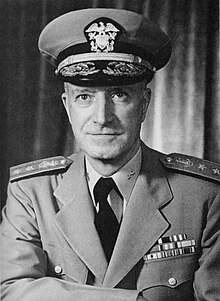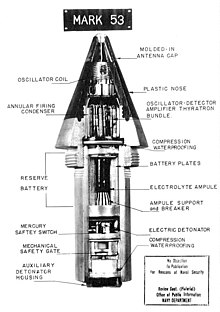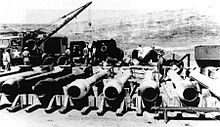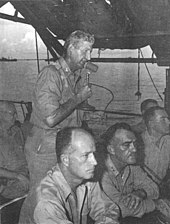William Sterling Parsons
William Sterling Parsons | |
|---|---|
 Parsons c. 1946–1953 | |
| Nickname(s) | Deak |
| Born | 26 November 1901 Chicago, Illinois, US |
| Died | 5 December 1953 (aged 52) Bethesda, Maryland, US |
| Place of burial | |
| Allegiance | United States |
| Service/ | United States Navy |
| Years of service | 1922–1953 |
| Rank | Rear admiral (upper half) |
| Battles/wars | |
| Awards | |
| Alma mater | United States Naval Academy (BS) |
William Sterling Parsons (26 November 1901 – 5 December 1953) was an American naval officer who worked as an ordnance expert on the Manhattan Project during World War II. He is best known for being the weaponeer on the Enola Gay, the aircraft which dropped an atomic bomb on Hiroshima, Japan, in 1945. To avoid the possibility of a nuclear explosion if the aircraft crashed and burned on takeoff, he decided to arm the bomb in flight. While the aircraft was en route to Hiroshima, Parsons climbed into the cramped and dark bomb bay, and inserted the powder charge and detonator. He was awarded the Silver Star for his part in the mission.
A 1922 graduate of the United States Naval Academy, Parsons served on a variety of warships beginning with the battleship USS Idaho. He was trained in ordnance and studied ballistics under L. T. E. Thompson at the Naval Proving Ground in Dahlgren, Virginia. In July 1933, Parsons became liaison officer between the Bureau of Ordnance and the Naval Research Laboratory. He became interested in radar and was one of the first to recognize its potential to locate ships and aircraft, and perhaps even track shells in flight. In September 1940, Parsons and Merle Tuve of the National Defense Research Committee began work on the development of the proximity fuze, an invention that was provided to the US by the UK Tizard Mission, a radar-triggered fuze that would explode a shell in the proximity of the target. The fuze, eventually known as the VT (variable time) fuze, Mark 32, went into production in 1942. Parsons was on hand to watch the cruiser USS Helena shoot down the first enemy aircraft with a VT fuze in the Solomon Islands in January 1943.
In June 1943, Parsons joined the Manhattan Project as Associate Director at the
After the war, Parsons was promoted to the rank of rear admiral without ever having commanded a ship. He participated in Operation Crossroads, the nuclear weapon tests at Bikini Atoll in 1946, and later the Operation Sandstone tests at Enewetak Atoll in 1948. In 1947, he became deputy commander of the Armed Forces Special Weapons Project. He died of a heart attack in 1953.
Early life
William Sterling Parsons was born in Chicago, Illinois, on 26 November 1901, the oldest of three children of a lawyer, Harry Robert Parsons, and his wife Clara, née Doolittle. Clara was the granddaughter of
In 1909, the family moved to Fort Sumner, New Mexico,[1] where William learned to speak fluent Spanish.[2] He attended the local schools in Fort Sumner and was home schooled by his mother for a time. He commenced at Santa Rosa High School, where his mother taught English and Spanish, rapidly advancing through three years in just one. In 1917 he attended Fort Sumner High School, from which he graduated in 1918.[3]
In 1917 Parsons traveled to Roswell, New Mexico, to take the United States Naval Academy exam for one of the appointments by Senator Andrieus A. Jones. He was only an alternate, but passed the exam while more favored candidates did not, and received the appointment. As he was only 16, two years younger than most candidates, he was shorter and lighter than the physical standards called for, but managed to convince the examining board to admit him anyway. He entered the Naval Academy at Annapolis, Maryland, in 1918, and eventually graduated 48th out of 539 in the class of 1922, in which Hyman G. Rickover graduated 107th. At the time, it was customary for midshipmen to acquire nicknames, and Parsons was called "Deacon", a play on his last name. This became shortened to "Deak".[4]
Ordnance
On graduating in June 1922, Parsons was commissioned as an
The ordnance course was normally followed by a relevant field posting, so Parsons was sent to the
In July 1933, Parsons became liaison officer between the
Some thought that Parsons was ruining his career with his advocacy of radar,[15] but he acquired one powerful backer. The Chief of the Bureau of Aeronautics (BuAer), Rear Admiral Ernest J. King, supported the use of radar as a means of determining aircraft altitude. When the Bureau of Engineering protested that such a device would necessarily be too large to carry on a plane, King told them that it would still be worthwhile, even if the only aircraft in the Navy big enough to carry it was the airship USS Macon.[16]
Parsons's marriage produced three daughters. The first, Hannah, was born in 1932; the second, Margaret (Peggy), followed in 1934. Hannah died of polio in April 1935.[17][18] Parsons returned to sea in June 1936 as the executive officer of the destroyer USS Aylwin. He was promoted to lieutenant commander in May 1937. His third daughter, Clara (Clare), was born the same year. On that occasion, Parsons left Martha with the newborn and three-year-old Peggy to care for and reported for duty the next day, believing that his first responsibility was to his ship. His skipper, Commander Earl E. Stone, did not agree, and sent him home. In March 1938, Rear Admiral William R. Sexton had Parsons assigned to his flagship, the cruiser USS Detroit, as gunnery officer. Parsons's task was to improve the gunnery scores of his command, and in this he succeeded.[19]
Proximity fuze

Parsons was posted back to Dahlgren in September 1939 as experimental officer. The atmosphere had changed considerably. In June 1940, President
In September 1940, Parsons and
The ideal solution was a
On 29 January 1942, Parsons reported to Blandy that a batch of fifty proximity fuzes from the pilot production plant had been test fired, and 26 of them had exploded correctly. Blandy therefore ordered full-scale production to begin. In April 1942, Bush, now the Director of the
Parsons had the new proximity fuzes, now known as VT (variable time) fuze, Mark 32, flown to the
To preserve the secrecy of the weapon, its use was initially permitted only over water, where a dud round could not fall into enemy hands. In late 1943, the Army obtained permission for it to be used over land. It proved particularly effective against the
Manhattan Project
Project Y

Parsons returned to Dahlgren in March 1943.
Groves told them that he was looking for someone with "a sound understanding of both practical and theoretical ordnance – high explosives, guns and fusing – a wide acquaintance and an excellent reputation among military ordnance people and an ability to gain their support; a reasonably broad background in scientific development; and an ability to attract and hold the respect of scientists."[34] He said that a military officer would be his ideal, as the job might involve planning and coordinating the use of the bomb, but added that he knew of no Army officer who fit the bill. Bush then suggested Parsons, a nomination supported by Purnell.[35] The next morning, Parsons received a phone call from Purnell, ordering him to report to Admiral King, who was now the commander in chief, US Fleet (Cominch). In a terse ten-minute meeting, King briefed Parsons on the Project, which he said had his full backing.[36] That afternoon, Parsons met with Groves, who quickly sized him up as the right man for the job.[35]

Parsons was relieved of his duties at Dahlgren and officially assigned to Admiral King's Cominch staff on 1 June 1943, with a promotion to the rank of captain. On 15 June 1943, he arrived at Los Alamos as Associate Director.[37] Parsons would be Oppenheimer's second in command.[38] Parsons and his family moved into one of the houses on "Bathtub Row" that had formerly belonged to the headmaster and staff of the Los Alamos Ranch School. Bathtub Row, so-called because the houses were the only ones at Los Alamos with bathtubs, was the most prestigious address at Los Alamos.[39] Parsons became Oppenheimer's next-door neighbor,[40] and in fact his house was slightly larger, because Parsons had two children and Oppenheimer, at this point, had only one.[41] With two school-age children, Parsons took a keen interest in the construction of the Central School at Los Alamos, and became president of the school board. Instead of the temporary two-story structure that Groves had envisioned in the interest of economy and not misusing the project's high priorities for labor and materials, Parsons had a well-built, modern, single-story school constructed. On seeing the result, Groves said: "I'll hold you personally responsible for this, Parsons."[42]
Oppenheimer had already recruited key people for Parsons's Ordnance Division.

Groves, among others, felt that Parsons had a tendency to fill positions with naval officers. There was some aspect of service parochialism, and Parsons believed that involvement in the Manhattan Project would be important for the future of the Navy, but it was also due to the difficulty of getting highly skilled people from any source in wartime. Parsons simply found it easiest to get them through Navy channels.[45] Lieutenant Commander Norris Bradbury said that he did not wish to join Project Y, but was soon on his way to Los Alamos anyway.[46] Parsons recruited Commander Francis Birch, who replaced McMillan at Anchor Ranch.[47] Commander Frederick Ashworth was a naval ordnance officer and aviator who was senior aviator at Dahlgren when he was brought in to work on the delivery side.[48] By the end of the war, there were 41 Naval officers at Los Alamos.[49]
Over the next few months, Parsons's division designed the gun-type plutonium weapon, codenamed Thin Man. It was assumed that a uranium-235 weapon would be similar in nature. Hirschfelder's group considered various designs, and evaluated different propellants.[50] The ordnance test area, which became known as "Anchor Ranch", was established on a nearby ranch, where Parsons conducted test firings with a 3-inch anti-aircraft gun.[51] Work on implosion lagged by comparison, but this was not initially a major concern, because it was expected that the gun-type would work with both uranium and plutonium. However, Oppenheimer, Groves and Parsons lobbied Purnell and Tolman to get John von Neumann to have a look at the problem. Von Neumann suggested the use of shaped charges to initiate implosion.[52]

Oppenheimer considered that there was a "reciprocal lack of confidence" between Parsons and Neddermeyer,[53] and in October 1943 he brought in George Kistiakowsky, who began a new attack on the implosion design.[53] Kistiakowsky clashed with both Parsons and Neddermeyer, but felt that "my disagreements with Deak Parsons were very minor compared to my disagreements with Neddermeyer."[54] The implosion design acquired a new urgency in April 1944, when studies of reactor-produced plutonium confirmed that it could not be used in a gun-type weapon. An accelerated effort was called for to design and build the implosion-type weapon, codenamed Fat Man. Two new groups were created at Los Alamos: X (for explosives) Division headed by Kistiakowsky, and G (for gadget) Division under Robert Bacher. Parsons was placed in charge of O (for ordnance) Division, with responsibility for both the gun-type design and delivery.[55]
The uranium gun-type weapon known as Little Boy did prove to be simpler than Thin Man. The gun velocity needed to be only 1,000 feet per second (300 m/s), a third that of Thin Man. A corresponding reduction in the barrel length reduced the bomb's overall length to 6 feet (1.8 m). In turn, this made it much easier to handle, and permitted a conventional bomb shape, resulting in a more predictable flight.[56] The main concerns with Little Boy were its safety and reliability.[57]
Project Alberta

The delivery program, codenamed

In July 1944, Parsons joined Jack Crenshaw, who was investigating the
You will sail at high speed to Tinian where your cargo will be taken off by others. You will not be told what the cargo is, but it is to be guarded even after the life of your vessel. If she goes down, save the cargo at all costs, in a lifeboat if necessary. And every day you save on your voyage will cut the length of the war by just that much.[63]
Parsons was in charge of scientists and technicians from Project Alberta on Tinian, who were nominally organized as the 1st Technical Service Detachment. Their role was the handling and maintenance of the nuclear weapons. Parsons was joined by Purnell, who represented the Military Liaison Committee, and Brigadier General
In the space of a week on Tinian, four B-29s crashed and burned on the runway. Parsons became very concerned. If a B-29 crashed with a Little Boy, the fire could cook off the explosive and detonate the weapon, with catastrophic consequences. He raised the possibility of arming the bomb in flight with Farrell, who agreed that it might be a good idea. Farrell asked Parsons if he knew how to perform this task. "No sir, I don't", Parsons conceded, "but I've got all afternoon to learn."[65] The night before the mission, Parsons repeatedly practiced inserting the powder charge and detonator in the bomb in the poor visibility and cramped conditions of the bomb bay.[66]
Parsons participated in the
Postwar career
In November 1945, King created a new position of Deputy Chief of Naval Operations for Special Weapons, which was given to Vice Admiral Blandy. Parsons became Blandy's assistant. In turn, Parsons had two assistants of his own, Ashworth and Horacio Rivero Jr. He also brought Greenbacker from Los Alamos to help set up the new office.[70] Parsons was a strong supporter of research into the use of nuclear power for warship propulsion, but disagreed with Rear Admiral Harold G. Bowen Sr., the head of the Office of Research and Inventions, who wanted the US Navy to initiate its own nuclear project. Parsons felt that the Navy should work with the Manhattan Project, and arranged for Navy officers to be assigned to Oak Ridge. The most senior of them was his former classmate Rickover, who became assistant director there. They immersed themselves in the study of nuclear energy, laying the foundations for a nuclear-powered navy.[71]

On 11 January 1946, Blandy was appointed to command Joint Task Force One (JTF-1), a special force created to conduct a series of nuclear weapon tests at Bikini Atoll, which he named Operation Crossroads, to determine the effect of nuclear weapons on warships.[72] Parsons, who was promoted to the rank of rear admiral on 8 January 1946, became Blandy's Deputy Commander for Technical Direction and Commander Task Group 1.1.[5] Parsons worked hard to make a success of the operation, which he described as "the largest laboratory experiment in history".[73] In addition to the 95 target ships, there was a support fleet of more than 150 ships, 156 aircraft, and over 42,000 personnel.[74]
Parsons witnessed the first explosion, Able, from the deck of the task force flagship, the command ship USS Mount McKinley. An airburst like the Hiroshima blast, it was unimpressive, and even Parsons thought that it must have been smaller than the Hiroshima bomb. It failed to sink the target ship, the battleship USS Nevada, mainly because it missed it by a considerable distance. This made it difficult to assess the amount of damage caused, which was the objective of the exercise. Blandy then announced that the next test, Baker, would occur in just three weeks. This meant that Parsons had to carry out the evaluation of Able simultaneously with the preparations for Baker. This time he assisted with the final preparations on USS LSM-60 before heading back to seaplane tender USS Cumberland Sound for the test. The underwater Baker explosion was no larger than Able, but the dome and water column made it look far more spectacular. The real problem was the radioactive fallout, as Colonel Stafford L. Warren, the Manhattan Project's medical advisor, had predicted. The target ships proved impossible to decontaminate and, lacking targets, the test series had to be called off.[75] For his part in Operation Crossroads, Parsons was awarded the Legion of Merit.[76]
The Special Weapons Office was abolished in November 1946, and the Manhattan Project followed suit at the end of the year. A civilian agency, the
Death and legacy
Parsons remained in contact with Oppenheimer. The two men and their wives visited each other from time to time, and the Parsons family especially enjoyed visiting their former neighbors at their new home at Olden Manor,
The
In popular culture
Parsons was depicted in the following films or television works:
- The Beginning or the End (1947) by Warner Anderson
- Above and Beyond (1952) by Larry Gates
- Enola Gay: The Men, the Mission, the Atomic Bomb (1980) by Robert Pine
- Day One (1989) by Dee McCafferty
- Fat Man and Little Boy (1989) by Michael Brockman
- Hiroshima (1995) by Gary Reineke
Notes
- ^ Christman 1998, pp. 6–9.
- ^ Christman 1998, p. 17.
- ^ Christman 1998, pp. 12–13.
- ^ Christman 1998, pp. 13–18.
- ^ a b c d e "Parsons". US Naval Historical Center. Archived from the original on 22 October 2012. Retrieved 23 July 2011.
- ^ Christman 1998, p. 25.
- ^ Christman 1998, pp. 29–30.
- ^ Christman 1998, pp. 32–34.
- ^ Christman 1998, pp. 38–39.
- ^ Christman 1998, pp. 38–40.
- ^ Ault, Jon. "William Sampson". Spanish American War Centennial Website. Retrieved 24 July 2011.
- ^ Christman 1998, p. 45.
- ^ Terrett 1953, pp. 39–41.
- ^ Christman 1998, pp. 45–49.
- ^ Christman 1998, p. 49.
- ^ Christman 1998, p. 53.
- ^ a b "William Sterling Parsons Rear Admiral, United States Navy". Arlington National Cemetery. Retrieved 24 July 2011.
- ^ Christman 1998, pp. 43, 54–55.
- ^ Christman 1998, pp. 57–61.
- ^ Christman 1998, pp. 72–73.
- ^ Christman 1998, pp. 74–77.
- ^ Brennan, James W. (December 1968). "The Proximity Fuze Whose Brainchild?". United States Naval Institute Proceedings: 72–78. Retrieved 6 April 2019.
- ^ Furer 1959, pp. 346–347.
- ^ Christman 1998, pp. 86–91.
- ^ Furer 1959, p. 348.
- ^ "Radio Proximty (VT) Fuzes". Naval Historical Center. Archived from the original on 9 February 2014. Retrieved 24 July 2011.
- ^ Christman 1998, pp. 96–98.
- ^ Morison 1948, pp. 329–330.
- ^ Furer 1959, p. 349.
- ^ Christman 1998, p. 102.
- ^ Christman 1998, pp. 106–107.
- ^ Hoddeson et al. 1993, pp. 83–84.
- ^ Groves 1962, pp. 24–25.
- ^ Groves 1962, pp. 159–160.
- ^ a b Groves 1962, p. 160.
- ^ Christman 1998, p. 108.
- ^ Christman 1998, pp. 112–115.
- ^ Christman 1998, p. 148.
- ^ Hunner 2004, p. 32.
- ^ Hunner 2004, p. 193.
- ^ Christman 1998, p. 118.
- ^ Hunner 2004, pp. 50–51.
- ^ Christman 1998, pp. 120–127, 131.
- ^ Hoddeson et al. 1993, pp. 84–85.
- ^ Christman 1998, pp. 153–154.
- ^ Christman 1998, p. 139.
- ^ Christman 1998, p. 144.
- ^ Christman 1998, p. 152.
- ^ Christman 1998, p. 133.
- ^ Hoddeson et al. 1993, pp. 112–114.
- ^ Hoddeson et al. 1993, pp. 116–118.
- ^ Hoddeson et al. 1993, pp. 130–132.
- ^ a b Hoddeson et al. 1993, p. 137
- ^ Christman 1998, p. 138.
- ^ Hoddeson et al. 1993, pp. 242–246.
- ^ a b Christman 1998, p. 149.
- ^ Hoddeson et al. 1993, pp. 261–263.
- ^ Hoddeson et al. 1993, pp. 378–381.
- ^ Christman 1998, p. 167.
- ^ Christman 1998, pp. 154–155.
- ^ Christman 1998, pp. 170–171.
- ^ Christman 1998, pp. 173–174.
- ^ Thomas & Morgan-Witts 1977, p. 279.
- ^ Christman 1998, p. 176.
- ^ Lewis & Tolzer 1957, p. 72.
- ^ Thomas & Morgan-Witts 1977, p. 383.
- ^ Thomas & Morgan-Witts 1977, pp. 372–373.
- ^ "Citations for Awards of the Silver Star to U.S. Navy Personnel in World War II". Military Times. Archived from the original on 27 July 2010. Retrieved 26 July 2011.
- ^ Christman 1998, p. 204.
- ^ Christman 1998, pp. 210–211.
- ^ Hewlett & Duncan 1969, pp. 74–76.
- ^ Weisgall 1994, p. 31.
- ^ Christman 1998, pp. 220–221.
- ^ Shurcliff 1947, p. 2.
- ^ Christman 1998, pp. 224–231.
- ^ Christman 1998, p. 257.
- ^ Groves 1962, pp. 394–399.
- ^ Christman 1998, pp. 234–239.
- ^ Christman 1998, pp. 240–246.
- ^ Christman 1998, p. 242.
- ^ Bird & Sherwin 2005, p. 369.
- ^ Bird & Sherwin 2005, pp. 480–481.
- ^ Christman 1998, pp. 249–250.
- ^ a b Christman 1998, p. 258.
- ^ "Sea Service Awards Descriptions" (PDF). Navy League of the United States. Archived from the original (PDF) on 27 September 2011. Retrieved 23 July 2011.
- ^ Christman 1998, p. 253.
- ^ Willshaw, Fred. "USS Parsons (DD-949 / DDG-33)". NavSource Naval History. Retrieved 30 July 2011.
- ^ "Operation Crossroads: Bikini Atoll". 1946. Archived from the original on 20 January 2013. Retrieved 15 October 2007. Specifically, Charles Bittinger (1946). "Rear Admiral William Sterling Parsons, USN". Archived from the original on 5 November 2012. Retrieved 15 October 2007.
- ^ "Papers of William S. Parsons, Operational Archives Branch, Naval Historical Center, Washington, D.C." Retrieved 17 October 2015.
References
- OCLC 56753298.
- Christman, Albert B. (1998). Target Hiroshima: Deak Parsons and the Creation of the Atomic Bomb. Annapolis, Maryland: Naval Institute Press. OCLC 38257982.
- OCLC 1915787.
- OCLC 537684.
- OCLC 3717478.
- OCLC 26764320.
- Hunner, Jon (2004). Inventing Los Alamos: The Growth of an Atomic Community. Norman: University of Oklahoma Press. OCLC 154690200.
- Lewis, Robert A.; Tolzer, Eliot (August 1957). "How We Dropped the A-Bomb". Popular Science. pp. 71–75, 209–210.
- OCLC 4091661.
- OCLC 1492066. Retrieved 30 July 2011.
- Terrett, Dulaney (1953). The Signal Corps: The Emergency. Washington, DC: Office of the Chief of Military History, Department of the Army. OCLC 8990522.
- OCLC 252041787.
- Weisgall, Jonathan (1994). Operation Crossroads: The Atomic Tests at Bikini Atoll. Annapolis, Maryland: Naval Institute Press. OCLC 29477984.
